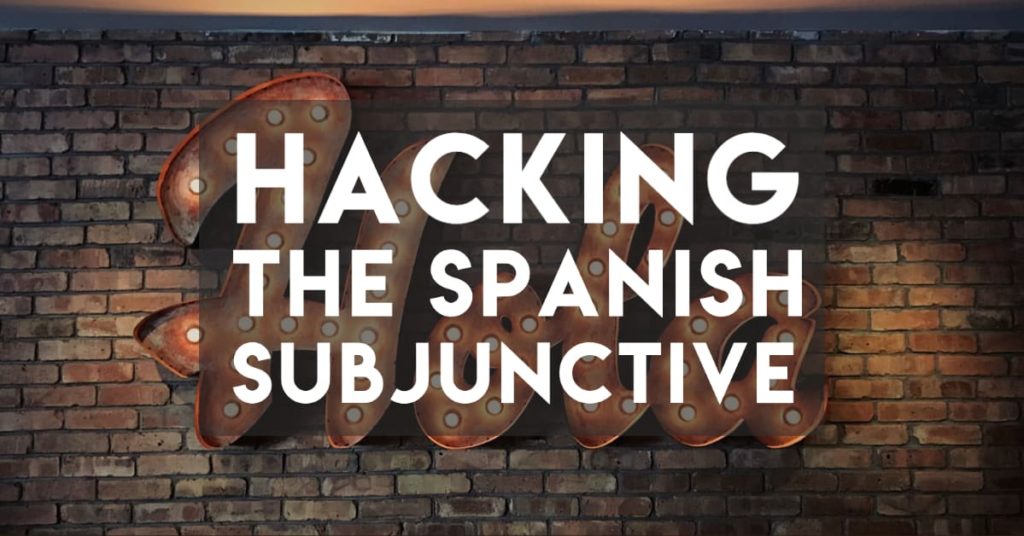Spanish Subjunctive Examples: 3-Step Cheat Sheet
This is a quick and dirty guide to hacking (I mean learning!) the Spanish subjunctive in the most common situations.
See below for Spanish subjunctive examples to explain the subjunctive simply, plus a simple 3-step guide to hack the most common Spanish subjunctive verbs and learn it 80-20 style.
We went to Colombia to learn to dance, but at the same time, I wanted to help out Jo my dance partner with getting past this nemesis of the subjunctive.
Back when I learned Spanish, I painstakingly learned every conjugation that exists. I knew conjugations for verbs I’d never even use in the subjunctive!
I learned weird explanations of the subjunctive (like what the subjunctive “mood” is) that made no sense to me, like that it expresses “uncertainty”.
In retrospect, this was massive overkill. Later, I realised that I mostly used the subjunctive for a bunch of verbs in certain phrases.
The better way to understand the subjunctive is through context — to understand the subjunctive was to know when they’re used, and to work backwards and learn how to make those phrases only.
So this is my three-step “backwards” guide to learning the Spanish subjunctive:
- Learn where and in what context the Spanish subjunctive is used — the most common phrases and expressions
- Learn with which verbs the Spanish subjunctive is most frequently used
- Learn the conjugations of those verbs with some simple rules

Become a Discoverer. Get the PDF summary.
Join our mailing list for weekly insights into culture, language, and exploring distant destinations, and we’ll send you the PDF version of this Spanish subjunctive cheat sheet as a study aid.
Contents
Step 1: The 9 Common Phrases Using the Spanish Subjunctive
Here are the kinds of sentences that use the subjunctive.
Despite using the subjunctive in a number of languages (Spanish, Farsi, French) like it’s second nature, I’ve never felt like I could easily describe the subjunctive in normal language without sounding like a bookish linguist.
It’s easier to just know the sentences need a subjunctive in them and then use the verb in the correct way.
I tend to notice when I’m using a subjunctive because I speak Spanish better than Jo (mostly as I have lived in purely Spanish-speaking environments for longer), so I’m on the lookout for ways to help her out with this difficult, long mission.
From my personal experience, here are the times when the subjunctive is most used in everyday language. (Feel free to tell us about more!)
| Spanish | English |
|---|---|
| I hope/I wish… I wish you told me earlier I trust we’ll have the time I hope you can come I hope you don’t think badly of me | Ojalá… Espero que… Ojalá me lo hubieras dicho antes Ojalá tengamos el tiempo Espero que puedas venir Espero que no pienses mal de mi |
| If I had/hadn’t… If one hadn’t… If I had more money, I’d buy it If you hadn’t come, we wouldn’t have this problem If it weren’t for him, we’d all be dead. | Si no (past subjunctive)… Si tuviera mas dinero me lo compraría Si no hubieras venido no tendríamos este problema Si no fuera por el, seríamos todo muertos. |
| I want you to/I need you to… I want you to tell me what’s going on I need you to listen carefully. What do you want me to do? | Quiero que… Necesito que… Quiero que me digas que esta pasando Necesito que me hagas caso Que quieres que haga? |
| So that… I’m telling you so that you know. Do it like this so it looks better. … so that we have more time | Para que… Te lo digo para que lo sepas. Hazlo así para que sea mas bonito. … para que haya mas tiempo |
| It’s important/necessary that… It’s important that you do it this way. It’s necessary that we be able to enter late. | Es importante/necesario que… Es importante que lo hagas así Es necesario que podamos entrar tarde. |
| May you… Have a good day! I hope everything goes well! May you be happy! | Que… ¡Que tengas un buen dia! ¡Que les vaya bien! ¡Que estén felices! |
| I don’t … I don’t want you to feel uncomfortable I don’t want this to be the only time I see you. | No… No quiero que estés incómoda. No quiero que esta sea la única vez que nos veamos. |
| Didn’t… I didn’t know if you wanted to come or not. I didn’t think it was like this. Didn’t you want me to do it? | No… No sabía si quisieras venir o no. No pensaba que fuera así. ¿No querías que lo hiciera? |
| Maybe… Whenever Maybe next time we see each other… We’ll start whenever he gets here. | Tal vez… en cuanto… Tal vez la próxima vez que nos veamos… Empezaremos en cuanto llegue. |
With that in mind, let’s think about the most commonly occurring Spanish verbs with which you have to learn the subjunctive.
Step 2: The 9 Most Common Spanish Subjunctive Verbs to Learn (but only those 9)
First, the bad news: the Spanish subjunctive is weird and hard for many English speakers. There’s a pattern of conjugation for many “regular” verbs, but unfortunately, the Spanish subjunctive is irregular for most common verbs.
The good news is that you don’t have to learn the Spanish subjunctive for every verb. You can 80-20 it and just learn the subjunctive for the most common verbs!
In general, we’re big fans of finding an 80-20 approach to language learning. This is just one example of that.
Below is a table of by far the most common verbs used in Spanish in the subjunctive form. This is based on personal experience speaking Spanish. Because I’m a language learner too, I always know when I’m using the subjunctive — unlike native speakers who just speak it naturally and don’t really notice.
| English | Spanish |
|---|---|
| To have, to exist | haber |
| To have (hold) | tener |
| To be (ongoing) | ser |
| To be (state) | estar |
| To do | hacer |
| To say | decir |
| To go | ir |
| To be able to | poder |
| To come | venir |
Based on that table (which I may expand… but hopefully not) let’s look at how to conjugate them.
Step 3: Conjugate the 9 most common Spanish subjunctive verbs
Now, for the subjunctive conjugations for these common Spanish verbs.
The conjugations for the most common verbs are all irregular. Each one has a subjunctive base that doesn’t necessarily look like the verb.
That means that there’s no fixed rule for how you get from the verb, e.g. hacer to the subjunctive root, e.g. haya.
The good news is that once you know the base of each subjunctive, it’s super easy to conjugate.
For example, ser. In the present tense, the first-person subjunctive is sea.
So you can make the following conjugations for yo, tu, el/ella, nosotros/as, vosotros/as (Spain only), ellos: sea, seas, sea, seamos, seáis, sean.
For hacer: haga, hagas, haga, hagamos, hagáis, hagan.
Exception to the exceptions: poder is slightly different (see below).
| Spanish | Subjunctive conjugation roots |
|---|---|
| haber | Present: haya Past: hubiera |
| tener | Present: tenga Past: tuviera |
| ser | Present: sea Past: fuera |
| estar | Present: esté Past: estuviera |
| hacer | Present: haga Past: hiciera |
| decir | Present: diga Past: dijera |
| ir | Present: vaya Past: fuera (same as ser) |
| poder | Present: pueda (note: podamos and podaís) Past: pudiera |
You just have to go memorize those conjugations now. Repeat them to yourself: pueda, puedas, pueda, podamos, podáis, puedan.
Then you can go building sentences.
Well, I hope this article has been helpful for you! If you have any concerns, don’t hesitate to contact me so I can improve the article for others. Hopefully next time we see each other you’ll be using the subjunctive without thinking.
Or, en español with the subjunctive:
Bueno, ¡espero que este artículo haya sido útil para ustedes! Si tienen alguna duda, no duden en contactarme para que pueda mejorar el artículo para otros. Tal vez la próxima vez que nos veamos estarás utilizando el subjuntivo sin pensar.







You have some errors you need to fix, e.g. hagas caso, and haz lo.
Thank you so much for this, I made those fixes.